The 67
Experiments with the K67 Capsule and EF86 tube
(Hear the Shoot-out at the bottom of the page)

The Neumann u67 microphone was created in 1960 as an modern version of the legendary u47. A new design was need fast when Telefunken informed Neumann that the supply of VF14 tubes for the u47 was finished!
I had the a client drop off an APEX 460 for repair recently. The customer had done a modification on their mic with a kit from another company. Everything worked well the first time he put it all back together, but when he tried to change the output capacitor, the magic stopped and so that is why our paths crossed.
The kit was a simple upgrade to a higher quality Peluso transformer and there was the option to get a Peluso K67 capsule. Now I had a P K67 capsule in a drawer in the shop but hadn't had time to play with it, so when I saw it I was excited to see how it performed.
Before the u67 was invented, the u47 microphone used a capsule that had the holes drilled in the back plate so that the frequency response of the capsule would be flat, or as flat as they could make it. This requires a complex pattern of holes with different sizes, some drilled through and others blind, that is complicated and expensive to make, especially before the days of computer controlled milling machines.
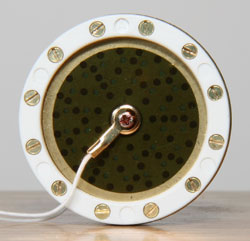 ___________
___________ 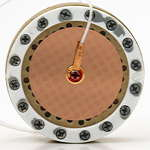 RK47 capsule shows the K47 hole pattern versus the P K67 matrix hole pattern
RK47 capsule shows the K47 hole pattern versus the P K67 matrix hole pattern
Another serious dis-advantage of the K47 was that it was machined in a single piece of brass. This meant that you had to get both sides exactly the same by cutting and drilling accurately. The K67 capsule is actually two capsules connected back to back. This means that you can make a pile of capsules, skin them, test their responses and only put capsules together that have matched responses. This is a more modern way to manufacture and leads to a higher percentage of useable pieces.
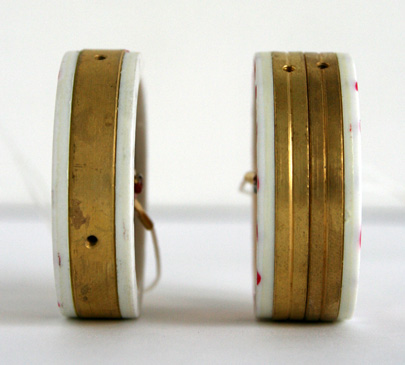
P K47 and P K67 side by side, showing one piece and two piece construction
With the new u67 capsule Neumann went with a mathematically organized set of holes that you can see in the image above. The side effect of that hole arrangement is the frequency response of the capsule rises slowly above 2KHz to a maximum of about 6dB at 11 to 13 KHz.
This rising response is very linear and as a result it is relatively simple to create an inverse response that "un-does" the capsules natural response. This is can be thought of as the acoustic equivalent of "pre-emphasis" with corresponding electronic "de-emphasis". Click the link to read more about this concept. It is used today in FM radio transmission and is required to optimize the signal to noise ratio of conventional analogue magnetic tape recording as well.
So after I repaired the microphone, I put it up on the acoustic sweep setup and here is what I saw.

Notice how the response is up 5.5 dB at 13Khz or so. This is by design. However this is not the response that Neumann wanted the u67 to have. No sir. They wanted a very neutral response on their new microphone that would be something closer to their treasured u47. You can see their published repsonse below from a 1961 manual.
Now in a very "Neumannesque" way, the circuit Neumann used made use of negative feedback that was picked up from the output via a special coil in the output transformer. These things are not available to me with a stock Apex 460, so I wanted to try it with simple RC filtering and see what I could do.
After adding a simple plate load bypass capacitor the response of the microphone became the following. The Peluso capsule really reproduces the slight dips in response in the lower mid-range at 200Hz and at 2Khz as well. And the mic actually took on that classic neutral sound you hear with the old u67.
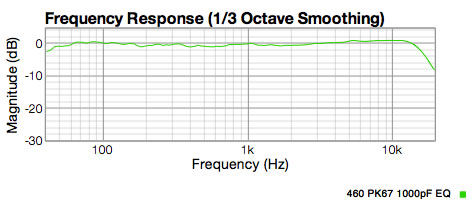
What this meant was that the Preamp response looked like this.
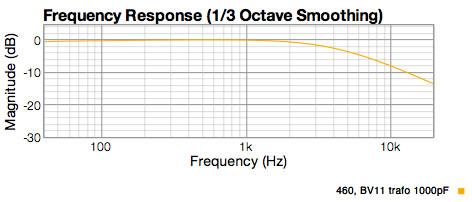
The Rest of the Story
So we spent the last few months experimenting with a way to create these mics without the complexitity of the original u67 circuit but still providing some of the benefits.
The u67 used the legendary EF86 tube wired as a triode. But it used a complex output transformer and a complex circuit. So for the rest of us we have created a new circuit with the EF86 tube and we engineered the circuit with a high ratio transformer so that we get low distortion without requiring negative feedback.
Then we use the simple passive EQ to correct the capsule response as above and voila. We got a great sounding microphone
Modern Tube Preamp Thinking
There are some people today are preferring NOT to use negative feedback in tube amplifers. The preference is to create a circuit that is designed for low distortion naturally. There is always a little delay in a the feedback loop which can lead to transient distortion. By avoiding negative feedback completely we eliminate that problem.
The upside of that is simplicity in the design, which makes it less expensive to make.
FAR 67/ FAR 47 Shootout
Below are two tracks that were simul-recorded with a FAR 47 Standard edition and the new prototype FAR 67 with EF86 tube preamp. I am amazed at how the two different microphones have similar characteristics even though the internals are different.
This to me is indicative of the fundamental Neumann thinking that went into the capsule designs many years ago.
Fox Audio Research 47 (Simul-recorded)
For the Budget Conscious
And of course speaking of budget, there is also a lower cost option for the capsule.
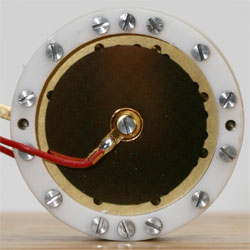
The RK67 capsule is very capable of giving similar results to the Pelsuo K67 with real savings in the pocket book. I will let you choose.
So all in all, I am very happy with this new design. It is our first date with the EF86 tube and I am very happy with her.
Click the link far a discussion of how we used the EF86 a little differently to create the FAR 67.
If a microphone in the u67 style interests you send us a note to request a quote at:

